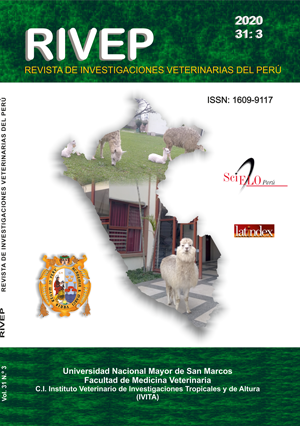Morphology analysis of the creole goat from the physiographic sub-province Volcanes de Colima, Mexico
DOI:
https://doi.org/10.15381/rivep.v31i3.16935Keywords:
creole goat, racial indices, functional indices, morphological harmony, zootechnical aptitudeAbstract
The aim of this study was to characterize the morphology of the creole goat of the Volcanes de Colima physiographic sub-province, Mexico. Seventeen body measurements were taken from 371 goats older than two years and four racial indices and 17 functional indices were calculated. Data were analysed using Pearson correlation, principal component, and hierarchical cluster analysis. The rump angle, chest width and all measurements of the ears and udder showed the greatest variability. Also, the goats showed great morpho-structural harmony. Racial indices showed that goats are dolichocephalic, ellipometric, and have a convex rump, while functional indices indicated dual-purpose zootechnical aptitude. Four principal components explained 84.5% of the variation of body measurements. Rump angle, hearth girth, body length and ear length presented the highest weighting coefficients in PC1, PC2, PC3 and PC4, respectively. The hierarchical cluster analysis classified the goats into four groups: group 1 has the lower rump angle, suitable for milk production; groups 2 and 3 with a phenotype tending to dual purpose, being able to focus on the production of meat or milk; and group 4 with a phenotype predisposed to meat production.
Downloads
Downloads
Published
Issue
Section
License
Copyright (c) 2020 Dámaris Abarca Vargas, Rafael Julio Macedo Barragán, Victalina Arredondo Ruiz, Mauricio Valencia Posadas, Miguel Angel Ayala Valdovinos, Juan Augusto Hernández Rivera

This work is licensed under a Creative Commons Attribution-NonCommercial-ShareAlike 4.0 International License.
AUTHORS RETAIN THEIR RIGHTS:
a. Authors retain their trade mark rights and patent, and also on any process or procedure described in the article.
b. Authors retain their right to share, copy, distribute, perform and publicly communicate their article (eg, to place their article in an institutional repository or publish it in a book), with an acknowledgment of its initial publication in the Revista de Investigaciones Veterinarias del Perú (RIVEP).
c. Authors retain theirs right to make a subsequent publication of their work, to use the article or any part thereof (eg a compilation of his papers, lecture notes, thesis, or a book), always indicating the source of publication (the originator of the work, journal, volume, number and date).










